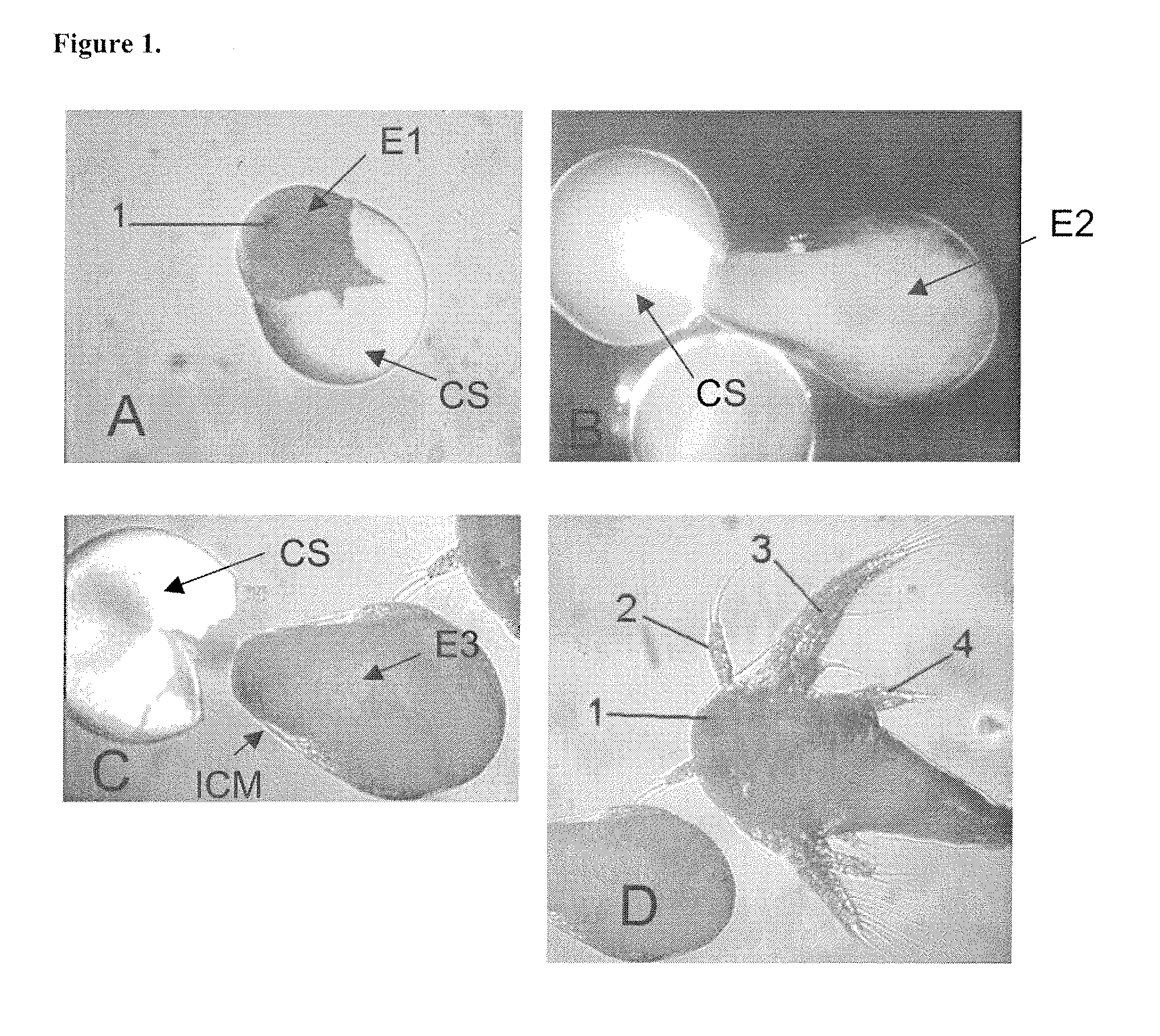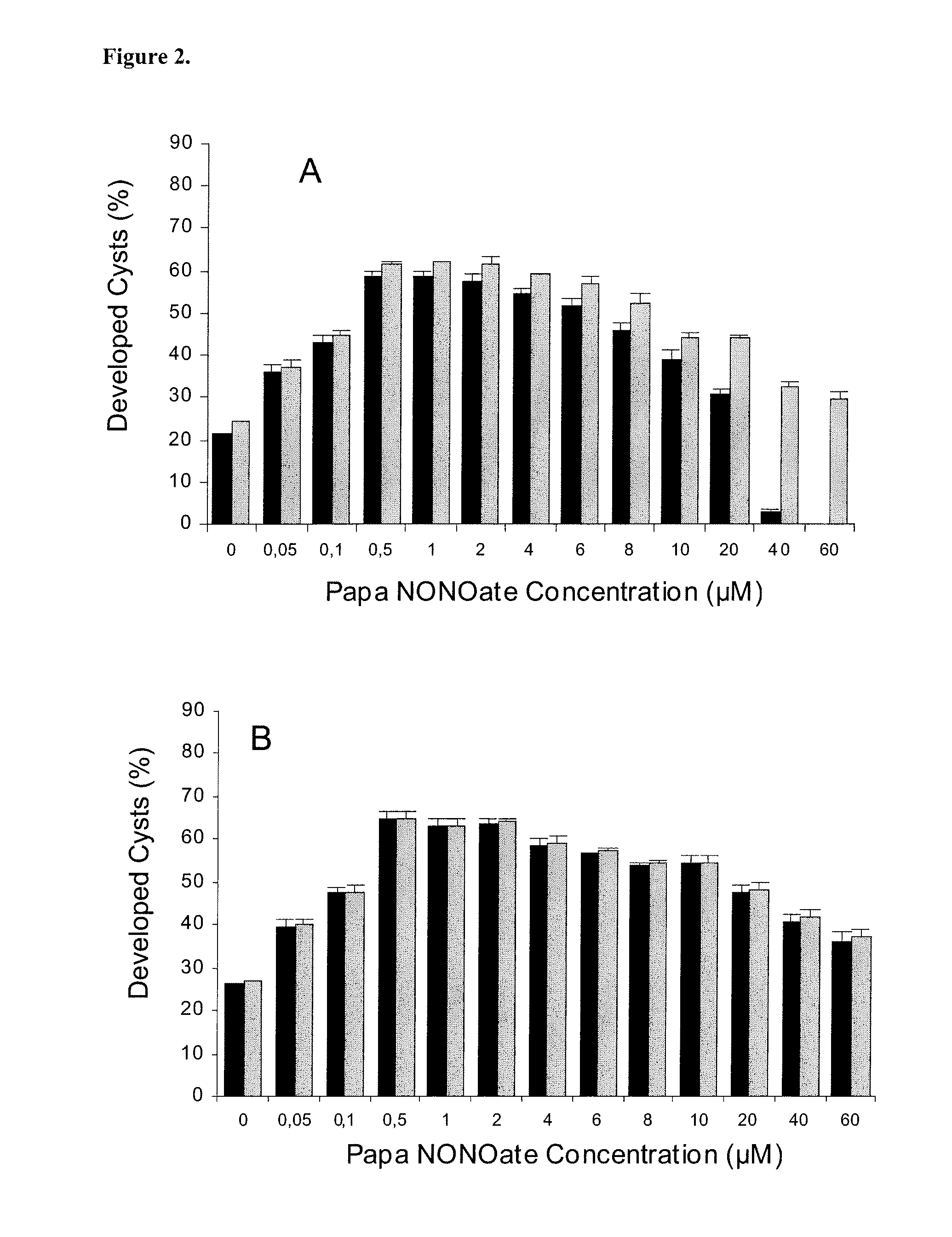Use of no and no donors for terminating dormancy in invertebrates
a technology for invertebrates and donors, applied in the field of no and no donors for terminating dormancy in invertebrates, can solve the problems of reducing hypoxia tolerance and causing termination
- Summary
- Abstract
- Description
- Claims
- Application Information
AI Technical Summary
Benefits of technology
Problems solved by technology
Method used
Image
Examples
example 1
Effect of NO-Donors on Post-Diapause Development of Encysted Artemia Embryos
[0215]1a. Effect of NO-Donors on Post-Diapause Development of Bolshoye Yaravoye Strain Encysted Artemia Embryos
Materials and Methods
Artemia Cysts
[0216]Encysted embryos (cysts) from a parthenogenetic strain of Artemia obtained in winter 2005-2006 in Bolshoye Yarovoye (Altay Region: 52° 51′64″ N-78° 37′32″ E), Russia (Artemia Reference Center (ARC) code number BY 1706), were stored in the dark at 4° C. in dry sealed bags. For the experiment, the cysts were grown at 26-28° C. with constant illumination in 25 ml of sea water under varying experimental conditions as detailed below.
Promotion of Cyst Development by NO
[0217]Tightly capped 50 ml plastic tubes containing 95.0±0.5 mg of Artemia cysts in artificial seawater (32 g salt / l, Instant Ocean®) supplemented separately with the NO donors (final concentrations between 0-60 μM)[0218]3-(2-hydroxy-2-nitroso-1-propylhydrazino)-1-propanamine(PapaNONOate) (half life 15...
example 2
Effect of SpermineNONOate in Diapaused Pupae of Heliothis virescens
Material and Methods
[0244]The larval stages of the tobacco budworm Heliothis virescens (Lepidoptera: Noctuidae) were reared on an artificial diet at standard conditions of 25° C. and long light conditions with 14 h light (Smagghe G et al., 1994). To produce nondiapause pupae, the larvae were kept at these conditions throughout development, whereas for pupal diapause induction, third instar larvae were transferred to 18° C. and short light conditions of 8 h light. The pupal stemma were examined to check the diapause status as described (Philips J R et al., 1966). Over 85% of the pupae entered diapause under those conditions.
[0245]Diapaused pupae of H. virescens were dipped for 30 minutes in a water solution of the NO-donor SpermineNONOate (purchased from Sigma) at 10, 100 and 1000 μM. The treatment was done in capped plastic Falcon tubes of 10 ml. Controls were dipped in distilled water. After treatment, pupae were p...
example 3
Effect of Sin-1 Chloride on Branchionus Resting Egg Hatching
Material and Methods
[0247]Resting eggs of Brachionus were suspended in 20 ml seawater (25 g / l), supplemented with different concentrations of Sin-1 Chloride (1-60 μM) and put in a falcon tube. These tubes were put on a rotor at 28° C. under constant illumination. The effect on the hatching rate was measured after 48 hr and 72 hr of incubation, by counting emerged rotifers in function of the amount of NO donor added.
Results
[0248]The results illustrate that in the presence or in the absence of the NO donor Sin-1 Chloride, ultimately between 35 and 40% of the resting eggs seem to hatch (table 3). Yet in the presence of 10 μM Sin-1 Chloride the hatching is faster, as after 48 hr incubation, 30% of the eggs had hatched (while in the negative control only 12.8% had hatched). After 72 h, the hatching in the negative control and in the treatment with 10 μM Sin-Chloride is not different. Note that in comparison with hatching in Arte...
PUM
| Property | Measurement | Unit |
|---|---|---|
| half life | aaaaa | aaaaa |
| concentrations | aaaaa | aaaaa |
| relevant humidity | aaaaa | aaaaa |
Abstract
Description
Claims
Application Information
 Login to View More
Login to View More - R&D
- Intellectual Property
- Life Sciences
- Materials
- Tech Scout
- Unparalleled Data Quality
- Higher Quality Content
- 60% Fewer Hallucinations
Browse by: Latest US Patents, China's latest patents, Technical Efficacy Thesaurus, Application Domain, Technology Topic, Popular Technical Reports.
© 2025 PatSnap. All rights reserved.Legal|Privacy policy|Modern Slavery Act Transparency Statement|Sitemap|About US| Contact US: help@patsnap.com



